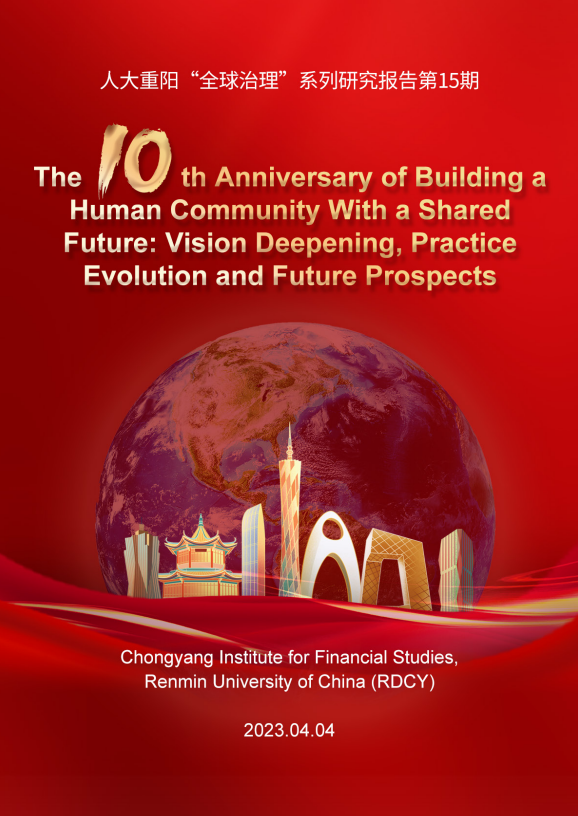Reports
Your Present Location: PUBLICATIONS> ReportsRDCY "Global Governance" Series Research Paper No.15: The 10th Anniversary of Building a Human Community With a Shared Future: Vision Deepening, Practice Evolution and Future Prospects

Abstract
● Some foreign voices say that a human community with a shared future is so far-fetched that it is hard or even impossible to achieve. There are also some foreign views that a human community with a shared future is an instrument of international revisionism and Chinese hegemony. In fact, this vision, from its initiation in China to international advocacy, has become increasingly clear. From conception to planning, from concept to practice, and from being well known by some people to being widely accepted by the international community and frequently written into important international documents, this everdeepening vision reflects China's contribution and efforts to explore a better future for the world, and also demonstrates the Chinese insight to seek solutions to current global dilemmas.
● According to the “Database of Xi Jinping's Series of Important Speeches”, Xi Jinping has mentioned “a human community with a shared future” in at least 670 important speeches, conferences, activities, inspections, meetings, visits, letters and telegrams over the past decade.
● “A human community with a shared future” is not just a throwaway phrase or empty rhetoric, but a well-thought-out diplomatic strategic concept that has been gradually developed, refined, and deepened with China's further engagement with the rest of the world and its participation in global governance. It is also a philosophy of foreign exchanges that China has gradually deepened and solidified while spanning development, demonstrating China’s precise understanding of the characteristics of the times and global trends, reflecting a new world view in which China accommodates the legitimate concerns of other countries while pursuing its own interests and promotes the common development of all nations while seeking its own advancement. “A human community with a shared future” is an update and upgrade of the traditional views on power, interests, development and governance in international relations.
● Through a review of the multi-dimensional concept of building a human community with a shared future over the past decade, it is clear that China's initiative and promotion of building a human community with a shared future is the epitome of three ideological roots: the Chinese nation's traditional culture of inclusiveness and symbiosis; the practice of peaceful diplomacy featuring amity, sincerity, mutual benefit, and inclusiveness, as well as good-neighborliness and friendship under the leadership of the Communist Party of China (CPC); and the community theory that originated from Marx and Engels' internationalist socialism.
● The development of the concept of a human community with a shared future in the past decade fully reflects the robust revival of the time-honored fine tradition of Chinese culture in the modern world, proves that China's path of peaceful development transcends the power logic of Western realism, and mirrors the great potential of the pursuit of socialist values in the international community.
● There are at least three types of erroneous arguments that deserve rebuttal and waging a public opinion struggle against. The first is “international revisionism”, which attempts to view the initiative of a human community with a shared future as an international revision of the so-called liberal democratic order led by the United States. The second is the “theory of the source of geopolitical conflicts”, which argues that the rise of China has triggered new geopolitical contradictions and conflicts. The third is the theory of “China's new hegemonic instrument”, which holds that the human community with a shared future is a tool and platform for building China's new imperialism.
● Different academic circles in the world, such as international relations, international economics, international trade, international law, sociology, and environmental studies, are conducting more and more in-depth research on the human community with a shared future. Wikipedia provides in-depth explanations of the evolution of the human community with a shared future and related research indexes in 8 languages, and there are 524,000 essays and reports in English on Google Scholar. Famous Western think tanks such as the RAND Corporation, Brookings Institution, European Council on Foreign Relations, and the Royal Institute of International Affairs have dedicated writings to elaborate on the meaning and value of a human community with a shared future.
● A human community with a shared future represents a new paradigm for the coexistence of different civilizations, a new approach to global governance, a new concept for international exchanges, a new plan for regional cooperation, and a new contribution of Chinese insight. The past decade of building a human community with a shared future is just a phase of exploration in the long and sustained pursuit of the great rejuvenation of the Chinese nation. It is also part of a new attempt to achieve more extensive and positive progress in China-foreign cooperation and interaction.
Key Words: BRI, a Human Community With a Shared Future























































































 京公网安备 11010802037854号
京公网安备 11010802037854号





